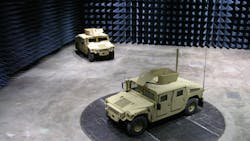Army asks industry to build anechoic chamber-based radar simulator to help protect future combat vehicles
ABERDEEN PROVING GROUND, Md. – U.S. Army researchers are asking industry to build a hardware-in-the-loop simulator to help evaluate radar detection and tracking capabilities for future combat vehicle protection systems.
Officials of the Army Contracting Command at Aberdeen Proving Ground, Md., issued a request for information (W56KGU-20-R-X001) this week for the Vehicle Protection System (VPS) simulator project.
Army researchers want a radar hardware-in-the-loop simulator for anechoic chamber experiments to assess radar detection and multi-object tracking capabilities in a transmitted RF scenario.
The simulator will operate in a government-furnished large anechoic chamber that measures 76 feet long by 34 feet wide by 32 feet high, and that has an RF and microwave frequency range of 30 MHz to 100 GHz.
The Army Contracting Command is issuing this notice on behalf of the Army Electronics Warfare Air/Ground Survivability (EWAGS) Division of the Combat Capabilities Development Command (CCDC) Command, Control, Communication, Computers, Cyber, Intelligence, Surveillance and Reconnaissance (C5ISR) Center in the Army Intelligence and Information Warfare Directorate (I2WD) at Aberdeen Proving Ground.
The simulator for combat vehicles system should have an interface to a radar system under test that operates in two modes: an active search mode looking for targets of interest, and a cued-only mode accepting cues from an external source.
The system also should be able to generate targets of interest with repeaters, RF simulators, or some other method for collecting the radar signal and generating the targets of interested based on a simulation. Targets should have representative radar cross sections and speeds.
The system also should be able to generate at least four simultaneous targets at different angles relative to the radar -- in particular at least two targets by 90 degrees. Majority targets can be static in angle, but at least one target should be able to show angular displacement in at least one dimension.
Related: Army looks to DRS Land Systems for active protection aboard M1A2 Abrams main battle tanks
The Army's frequencies of interest include X through Ka band. Targets should have radar cross section values of zero decibels relative to one square meter down to -30 decibels relative to one square meter; and velocities ranging from 50 to 1000 meters per second.
Researchers want the winning contractor to build and demonstrate the system at offsite vendor location, and support its installation into the government's anechoic chamber.
Responses should included approximate costs related to non-recurring engineering, to include training, materials, onsite SETA support, travel, and other direct costs.
Companies interested should email 30-page responses no later than 8 Nov. 2019 to the Army at [email protected].
Email questions or concerns to the Army's Maurice Hinkson at [email protected]. More information is online at https://www.fbo.gov/notices/4cc16cc677891d7cedb2fc62c29786d4.
About the Author
John Keller
Editor-in-Chief
John Keller is the Editor-in-Chief, Military & Aerospace Electronics Magazine--provides extensive coverage and analysis of enabling electronics and optoelectronic technologies in military, space and commercial aviation applications. John has been a member of the Military & Aerospace Electronics staff since 1989 and chief editor since 1995.

